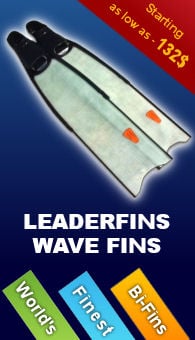Equalization Techniques
As already discussed in the physiology chapter, our body contains air spaces which are exposed to pressure changes during freediving. These pressure changes must be compensated in order to avoid barotrauma (pressure related injury). This article will examine several techniques of pressure equalization in the facial air cavities and the compensation of the mask. It is important to remember that compensation is a very individual thing, there is no 'correct' amount of pressure equalization maneuvers for a certain depth.
Equalization Safety Rules
The equalization must come BEFORE the feeling of pain in the ears or sinuses.
In case pressure equalization is not possible or happens only partially abort the dive and ascend immediately!
Do not, under any circumstances, continue descend if you are unable to equalize pressure in your ears or sinuses, this WILL cause a rapture in the eardrum which may lead to a complete loss of hearing ability in the injured ear and WILL cause sinus squeeze which may in turn permanently damage the skull!
The Valsalva Maneuver
The Valsalva maneuver, named after Antonio Valsalva who was the first to record the pressurization of the middle ears in the 1700's, is performed by forcibly exhaling against closed lips and pinched nose. This forces air from the lungs into the middle ear if the Eustachian tube is open. This is the most common technique of compensation among freedivers, however, this technique is only effective in depths of up to -30 meters. In greater depths there simply isn't enough air left in the lungs to equalize the pressure in the ears and sinuses. This technique also causes the contraction of the lung muscles - an oxygen consuming practice.
To perform the Valsalva maneuver:
1) Pinch your nose using your thumb and index finger.
2) Try exhaling forcefully through your nose as if it was open.
3) A 'clanck' sound should be heard as if coming from the inside of your ears.
4) Repeat underwater as many times as needed.
The Frenzel Maneuver
Herman Frenzel was the Luftwaffe commander who taught this technique to dive-bomber pilots during the World War II. The technique is to close off the vocal cords, as though you are about to lift a heavy weight. The nostrils are pinched closed and an effort is made to make a 'k' or a 'guh' sound. By doing this you raise the back of the tongue and the 'Adam's Apple' will elevate. This turns the tongue into a piston, pushing air up. This maneuver can be done relatively effortlessly and is not as oxygen consuming as the valsalva maneuver. It can be repeated many times quickly underwater and is effective in depths of up to -80 meters. For a manual of Frenzel, an advanced variation of this technique and more general information about equalization see the Frenzel-Fattah manual.
The BTV (VTO) Maneuver
Stands for 'Beance Tubaire Volontaire'. In the 1950's the French navy developed a technique for middle ear equalization called 'Voluntary Tubal Opening'. This technique is difficult to teach and only approximately 30% of taught can perform it reliably. Muscles of the soft palate are contracted while upper throat muscles are employed to pull the Eustachian tube open. This technique is similar to the events that happen in the back of your throat at the end of a yawn. It is also similar to wiggling your ears and some people seem to be born with the talent. For a manual of BTV see the BTV (VTO) manual.
The Wet Equalization Maneuver
Performed by allowing water to flood the sinuses - by doing this the freediver cancels the need for air in order to equalize the pressure in the middle ear and sinuses. The freediver may chose to use the Frenzel maneuver in order to push water into the inner ear to reduce the air space further. This technique requires a lot of training to prevent aspiration of water into the lungs and drowning. The practice of this technique may cause infection of the ear and sinuses.
The Toynbee Maneuver
Joseph Toynbee lived in the 1800's and was the first to identify the crackling sound present in ones head with the anatomical opening of the Eustachian tubes during swallowing. His technique is to pinch nostrils shut while swallowing. The muscles in the back of the throat pull open the Eustachian tube and allow air to equalize if a gradient is present. Using this technique during a freedive, there is very little or no margin for error if the Eustachian tube doesn't equalize on first effort.
Equalization Of The Mask
To equalize the pressure in the mask the freediver must simply blow a small amount of air out of his nose into the mask (This is why a mask with a nose pocket so important for freediving). Usually, when performing the Valsalva or Frenzel maneuvers, some air 'leaks' out of the nose into the mask during or right after the equalization of the ears and thus equalizing the mask. Equalizing the mask becomes trickier at greater depths when the air volume in the lungs decreases. Many freedivers who dive to great depths don't use a mask during the dive or use Fluid Goggles, which are filled with liquid and do not need to be equalized.
Personalization
As already mentioned before, equalization is a very individual thing, many people use different combinations of the techniques described here with their own maneuvers. The author of this article, for example, uses a technique of pushing the jaw outwards and downwards while swallowing to equalize. It is important to give everything a try in the water to really know what works for you and what doesn't.
Thursday, March 27, 2008
Equalization Techniques
Posted by
Anon
at
12:21 AM
Labels:
Basics Of Freediving - Equalization Techniques free diving release mask pressure
Subscribe to:
Post Comments (Atom)








In the paragraph in red at the start:
ReplyDelete"... this WILL cause a rapture in the eardrum".
"Rapture" does sound much nicer than "rupture" ;-)
I have learned the BTV maneuver during my first flights. Once I started freediving I was taught the valsalva maneuver and quickly found that it's not as effective plus it's very energy consuming so I turned back to my BTV, had no problems using it ever since. If you can induce yawning you can easily learn to perform the BTV.
ReplyDeleteHello, please delete the comment asking about ear discomfort during flights. It is a comment from me.
ReplyDeleteI would really appreciate it, thank you.
If used timely, the moving forward of the lower jaw can also be used to activate the muscles of Eustachian tubes, but if you allow the pressure difference to become too strong, it might not work. Try it in small increments and often you won't have to touch your nose at all.
ReplyDeleteHi, I am able to equalise at the surface but am unable to on the way down free-diving. However with a tank I can equalise on the descent, does anyone know why I am unable to do so free diving? At the moment I equalise by pinching my nose and blowing.
ReplyDeleteYou should try and learn the Frenzel maneuver. It can greatly help in situations like you describe.
DeleteBit of a late response, but this could be due to head position. When on the surface and SCUBA diving you generally have your head in a neutral position and can easily equalize. When freediving, the temptation is to look where we are going as we dive down. This puts the head in an elevated position and makes equalizing more difficult.
DeleteTry looking straight ahead rather than directly down when you equalize.
The last time I went free diving I equalized and my right ear filled up with water. I got really dizzy and I still cant hear right after 3 weeks.
ReplyDeleteAnyone might know what I did wrong?
You may have ruptured your eardrum or performed equalization too late and your middle ear got filled with blood.
DeleteYou shuold seek medical attention immediately!
This comment has been removed by the author.
ReplyDeleteIt might be difficult to get those ideas but there is complete guide to follow each prospect so looking forward to achieve those levels for future success.
ReplyDeleteThe Valsalva is the easiest to go out and try but I feel the Frenzel is the most effective if you learn it.
ReplyDeleteThat is true. The Frenzel maneuver also allows equalization at greater depths than Valsalva which only really effectively works up to ~30m depths.
DeleteHello I find that my left ear can equalize but the right ear cant. Are there any tips. Thanks
ReplyDeleteThis comment has been removed by a blog administrator.
DeleteA very good and informative article indeed. It helps me a lot to enhance my knowledge, I really like this..
ReplyDelete